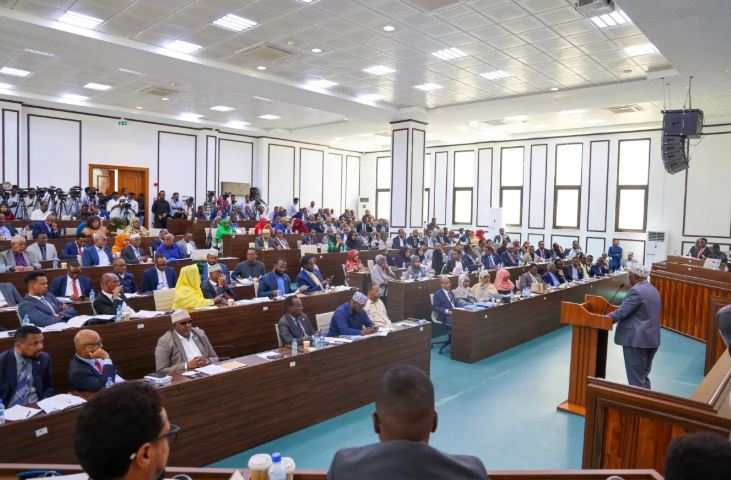How supermarket receipt linked Eastleigh murder suspect to another killing in Nairobi

By Amina Wako |
CCTV footage captured Deka shopping at a nearby supermarket, where she paid via M-Pesa, Kenya's mobile payment system. After collecting her receipt, she placed it in her pocket and exited the store, unaware of its significance.
A supermarket receipt has helped Nairobi police solve the puzzle of a severely mutilated body found near Lang’ata Cemetery.
On October 31, authorities discovered the dismembered and boiled body of Deka Abdinoor Gorone, a resident of the California Estate in Nairobi, dumped at the Lang'ata Cemetery entrance.
Keep reading
- Hashim Dagane to face murder charges in Eastleigh women killings case
- Research shows most GBV offenders are known to victims; communities often shield them
- Family seeks justice after body of missing Form Three student found in Bahati, Nairobi
- Security operation in Eastleigh after spate of killings makes residents jittery
Investigators have now identified her alleged killer as Hashim Dagane Muhumed, a man linked to other recent murders in Nairobi.
The investigation into Deka’s death began when her family reported her missing on October 24, a report filed at the California Police Station. Detectives tracked her last known movements following her disappearance thanks to CCTV footage, a series of digital trails, and, crucially, a receipt from a supermarket near her last known location.
Deka’s last known sighting was in Nairobi's Lavington area, where she had travelled to meet Hashim. The two checked into a short-stay room. Before joining him, CCTV footage captured Deka shopping at a nearby supermarket, where she paid via M-Pesa, Kenya's mobile payment system. After collecting her receipt, she placed it in her pocket and exited the store, unaware of its significance.
Police searching the scene recovered the receipt after discovering her body in a black plastic bag near the cemetery. They used it as a critical lead, identifying the supermarket and retrieving transaction details. Through digital forensics, they traced the mobile number used to pay for the shopping to Deka’s registered M-Pesa account, confirming her identity.
When detectives reached out to her family, they were able to identify her as Deka, the woman seen on CCTV. The family, already distressed by her unexplained disappearance, was devastated by the grim discovery.
Upon identifying her, detectives intensified their investigation by scrutinising her phone records. They discovered a string of conversations using a phone number belonging to Hashim, the primary suspect. This connection led them to an apartment in Lavington, where Deka had allegedly spent her last hours in the company of Hashim.
 Hashim Dagane was captured leaving a city apartment carrying two bags suspected to have contained the remains of the victim that were later in the day discovered at Langata cemetery. (Photo: DCI)
Hashim Dagane was captured leaving a city apartment carrying two bags suspected to have contained the remains of the victim that were later in the day discovered at Langata cemetery. (Photo: DCI)
During a search of the apartment, authorities discovered some of Deka’s personal belongings, including her shoes and handbag. They also recovered a panga, a machete-like tool believed to have been used in the murder. CCTV footage from October 31 shows Hashim leaving the apartment with two bags, which police suspect contained Deka's remains, later dumped at Lang'ata Cemetery.
Use of chemicals
Detectives believe the killer used a chemical to meticulously strip the bones of flesh. The motive behind the murder remains unclear, though Hashim’s connection to several murders suggests a disturbing pattern of violence.
Hashim’s background only deepened the horror surrounding the case. Investigators discovered that he was previously a regional police officer in Ethiopia before moving to Kenya. In Nairobi, he worked as a driver at various schools in Eastleigh and managed to blend into the local community.
This isn’t Hashim's first brush with the law. He had already been linked to the murders of three members of a family in Eastleigh: Amina Abdirashid, her aunt Waris Dahabo Daud, and her niece Nusayba Abdi Mohammed. Despite this history, Hashim remained elusive, shifting between Eastleigh and Lavington while occasionally venturing as far as Somalia and Ethiopia to evade capture.
The search for Hashim took a critical turn when an informant tipped off the police about his whereabouts. Surveillance footage from November 2 captured Hashim casually leaving a building in Eastleigh, which he frequented to scout for taxi customers. This sighting triggered an intensified manhunt, with investigators closely monitoring his movements through forensic trails and employing digital tracking to narrow down his location.
After days of evading arrest, Hashim finally surrendered when police surrounded the building where he was hiding. Realising escape was impossible, he was taken into custody on Sunday. Police discovered multiple fake identification documents in his possession, including a counterfeit Kenyan ID, raising questions about how he had managed to operate under the radar for so long.
With Hashim in custody, police are working to unravel the motive behind Deka’s killing. They are also investigating whether he had accomplices who helped him carry out the elaborate cover-up and dispose of the evidence. Among the unanswered questions is the whereabouts of Deka's mobile phone, from which her family reported receiving a call on the day of her discovery.
The landlord of the Lavington apartment, now missing, is also cited as a person of interest. After Hashim’s departure, the landlord reportedly repainted the rooms and cleared any evidence of the crime before disappearing, suggesting possible involvement or knowledge of the events that transpired.
Reader comments
Follow Us and Stay Connected!
We'd love for you to join our community and stay updated with our latest stories and updates. Follow us on our social media channels and be part of the conversation!
Let's stay connected and keep the dialogue going!













